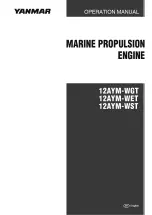
GE Energy Motors GEEP-427-I Copyright 2009, The General Electric Company, USA
18
GEEP-427-I Pegasus, Horizontal Induction Motor
TEWAC, Sleeve Bearing
6. Verify that the bearing housings on machines with
self-lubricated bearings have been filled to the proper
level.
7. The oil flow to each bearing housing on flood or
forced lubricated machines should be adjusted so the oil
level in each bearing housing is maintained.
8. All accessory devices should be connected and
operational.
9. All protective and control equipment should be
installed and operational.
10. The machine hold down bolts should be tightened
and the foot doweling completed.
11. The coupling alignment should be in accordance with
previous instructions.
12. The interior of the motor frame, top cover, terminal
boxes and fan casings (for Totally-enclosed Air-to-Air
Cooled Machines) should be free of tool, waste and other
foreign materials.
13. The air gap of the machine should be free of foreign
material.
14. Guards should be in position to protect personnel
from moving parts such as coupling, etc.
15.
Walls, baffles, other equipment, coupling guards,
etc., should not obstruct the necessary movement of air
required to adequately ventilate the machine.
16. Any load condition of the drives equipment which
contributes its load torque, at low speed, should be set
compatible with the starting torque specified for the
motor (i.e., if it is necessary to start the driven equipment
in an unloaded condition, in order to correspond to the
starting torque specified for the motor, then verify that
the driven equipment is appropriately unloaded).
17. All covers should be in place and properly secured.
The cover on the power terminal box and the accessory
terminal box should be properly secured.
Initial test run
The starting current of a motor is several times the
rated current. This starting current causes the windings to
heat at a much higher rate than normal and causes the
windings to heat at a much higher rate than normal and
causes magnetic forces on the end turns to be many times
normal. The section of this publication entitled
“Frequency of Starts and Load Inertia” should be read,
since the user may also be considering checkout and
adjustment of some of the control and protection
equipment at this time.
The limitations on starting
must be observed at all times to prevent damage to
the machine.
After verifying that the machine and the rest of
the system is ready for operation, a controlled initial start
should be made and a test run performed to verify that
the unit is properly installed and is operational. For this
run, it is recommended that several people be
appropriately located in order to observe any problems.
The following are the minimum steps to be taken on the
initial test run.
Note that the machine must be shut
down immediately if any problem occurs
.
1. If so equipped (See Outline Drawing), start
auxiliary lubrication system and verify oil flows. Also
check interlocking to make sure machine is prevented
from starting unless the lubrication system is functioning
and the machine will be shut down on the loss of
lubrication.
2. Start the machine. (For a generator, bring up
to speed with prime mover.)
3. Listen for any unusual noise during
acceleration and running.
Machines with oil-lubricated bearings only
.
4. Observe oil flow and/or oil ring action for
each bearing.
5. Verify that the rotor runs at the magnetic
center.
6. Observe and record each bearing temperature
and the rate at which it is increasing for each bearing.
Initially temperatures will rise rapidly and then should
level off.
NOTE:
Bearing temperatures should not
exceed 95C for a sleeve bearing.
Summary of Contents for Pegasus MHV GEEP-427-I
Page 46: ...GE Energy Motors 46 ...
















































